Mind Streaming
John Coxon's Online Journal|
Archive Search |
| Links |
|
and s-integrator |
Saturday, February 08, 2003
Cobbles or setts as they are sometimes called, are hand-hewn individual, irregular cubes of natural stone set into the ground to make , originally, a road surface hard enough to resist damage from horseshoes and steel cart wheel rims. Some cobbles on British streets are igneous (volcanic) in origin, either basalt, granite or gabbros and have a crystalline structure. They make for the most durable surface but are extremely hard to cut and shape. In the age of diamond tipped power saws I still wonder just how masons back then were able to cut such blocks. Most of the cobbles in this area were hewn by hand from sedimentary rocks. From discarded setts I have found on wasteground, I noticed that the edges of the individual stones are tarred, so originally the pavers piecing together the roads must have sealed the gaps with hot tar to keep them in place. There is quite an interesting web site http://www.pavingexpert.com/setts01.htm if you?d like to know more. Here you will see that there has been a revival in this method of surfacing , by gardeners and landscapers. There has been a trend, in the past few years, to have your driveway paved in brick to produce an attractive, maintenance-free surface ?Cobble? comes from a middle English word cobel ? a stone. In English, a cobbler isn?t a person who lays cobbles, it is a person who repairs shoes. To Cobble , as a verb, means to make a makeshift repair . Cobblers is slang for spoken rubbish or nonsense, hence 'you are talking a load of cobblers!' Just behind our home you can see what are'low rise' council flats. What is certain is that we are an increasingly crowded little island. With an eye on conservation and the preservation of areas of outstanding natural beauty and what is known as green belt land ( sacred countryside you can't build on) land for building is at a premium. As the population increases and high rise flats are no longer acceptable for a lot of people, low-rise new housing has become the norm but of course takes up more space. Land for private development is short ; the supply and demand rule means that any available land is very valuable, costs keep increasing and of course, often, to recoup those costs, far too many dwellings are cramped into these sites. The two stores near our home are owned by delightful and very friendly Asian families who richly deserve business success for the essential service they provide and their perpetual, unheralded, hard work. Sadly, in other towns, such enterprise and industry is not always understood or appreciated and there have been horrendous examples of deep-seated racial hatred that has some stores regularly under attack, mostly by gangs of anti-social kids, making the daily lives of some of these shopkeepers a living hell. That is a source of great shame to me. When the heating engineer turned up to instal a modern gas combi-boiler for me, a few months back, (to replace the ancient, energy-zapping old electric emersion heater), he hit problems. As he tried to route the new pipework, he came across giant sandstone slabs under the bathroom floorboards, where the old stone hearth used to be, and had to re-route the new pipes under the old bath. Our old bathroom was ancient and cramped. At six foot plus, a five foot bath was uncomfortable so I decided to rip out what used to be a chimney breast; that would enable me to build in extra cupboards , where the fireplace used to be, and re-locate the sink, instal a 'vanity' unit; put in a longer bath. It meant getting out those huge stone slabs to make new pipe work easier to lay. The image on the left shows the last stage of ripping out the wall; the right hand side shows how the new sink and cupboards slotted in to my design. When I tore down the wall of the chimney breast and got down to the old fire place, it had been filled in with discarded bricks, dust and ash and other debris. As I dug it away, I found this 'blast from the past.' When I was a child, 'Kensitas' was a popular brand because they gave away vouchers that you collected, in their thousands, to buy gifts. People chain smoked, in those days, just to get a 'free' picnic basket! You can't buy this brand anymore of course. I love the graphics and the nostalgia they stir in me. I have this thing about the sanctity of a building. I believe somethings belong to a home and should be respected, preserved and handed on. For me this cigarette packet is a part of the house's history. I framed the unfolded packet ( in surprisingly good condition) and it hangs on the wall in the new bathroom. It gives me a sense of continuity, of being the temporary guardian of a place that will, no doubt, be home to others when we have gone. I have to leave this item behind if I ever leave. No doubt, the stone flags, that were the hearth, will come in useful as an additional garden feature. I owe so much to my dad. He is and always has been a man of honour, proudly individual and unique. He did everything himself and I watched him as a kid, making and mending, finding a use for things and using hand tools with great skill. Ripping down the wall and installing a new bath, toilet and sink, doing all the woodwork and plumbing was something I just knew I could do. My dad could do all that stuff too, and passed on to me the confidence to do it. I inherited a certain ecentricity from dad, but also his code of honour, The wedding ring I used to wear did that to me metaphorically, but no need to dwell on that now. I exchanged gold rings once , in error, and lately wrote a song about a golden zero with nothing in it ! I once thought that pure gold is too soft to last, and that it needs impurities to give it strength. I had to experience that and it wasn?t pleasant. When I finally stopped trying, I ceremoniously removed my gold wedding ring for the last time, and rather than throw it away, having realised how completely worthless it had become for me, I gave it to my eldest son. In the period of my re-birth I bought a simple silver ring. I put the ring I brought on my right hand and it was a symbol for me of my right to be myself and love myself again. More recently, I took my real love (and her lovely daughter) on a holiday to Brittanny. We found a huge shopping mall with a ring stall. The lady searched for ages to find two traditional silver Celtic rings of the same design for us. Eventually we found matching rings and held a sort of unofficial wedding ceremony. We bought Naomi a silver ring too, and we just laughed and had a group hug. Here was no convention, no illusion, no disappointment, no deception , just preciously individual beings united soul to soul in a very special way. I feel married soul to soul to Angela , these two special years, but that gold ring held me in chains for twenty five years of my life and these silver rings just sit here, unnecessary in one way but links that tell me we are one and the same. On this street is our humble two-up, two-down pavement terraced home. In material terms, it is an eight of the value of the place I left at the end of an unhappy and unfulling marriage and a quarter of the size. In real terms it is priceless. In a gilded palace, where there is no love, both king and queen are miserable paupers. Here I have everything I ever wanted. Love and complete happiness. This is Angela's house. At the end of her last marriage she was left with nothing. She built a new life , from scratch, for her daughter and herself, with no one's help. This house is her achievement alone. I am blessed that she invited me to share it with her. I once saw a film from Roger Vadim, where Barbarella's guardian Angel said 'Angels don't make love: Angels are love'. I met and am loved by someone like that and I feel humbled. It is not something I ever had before, but always dreamed of. Our house, is a very nice house, as the song goes. In the absence of any substantial trees in the vicinity, it is not unusual for Craig and Debbie, under cover of darkness, to messily daub walls with their undying love for each other, but always on someone else's wall, or for gangs of kids to defecate, horizontally so to speak , spray painting their name tags. Happily there isn't a major problem with graffiti in the immediate area. Generally we get hurried roughwork from idle kids passing through to their own territory. At street level you don't crap on your own doorstep. The few exemplars of this genre of urban art we do see is of a very low artistic standard indeed, irritating but essentially innocent. It appears to be the work of those that can't draw but have at least learned to write their first name but sill need to practise it. This simple spray-paint maths equation appears on a wall close to home. It is more sinister. The fact that the word 'Grass' is intact, but the person's name to the left has been painted out is totally ironic. Community minded folks, with a notion of the sanctity of private property, paint out graffiti here, so it wasn't one of them. It must have been 'X' or more likely, one of his or her lackeys. X clearly belongs to the same sub culture, not the main species, where cleaning up after yourself, or taking responsibility for your actions isn't something you do instinctively, whereas crudely covering just your own tracks is. The phrase 'to grass on someone' is a London import, presumably by word of mouth. Grass is the nationally recognisable slang for a police informer. It derives from Cockney rhyming slang (grasshopper=copper), hence you are no better than a copper (policeman) if you 'grass someone up' to the law. The local underground of petty criminals and villains relies heavily on fear and anonymity. There is a laughable 'honour amongst thieves' code that even some law abiding neighbours sign up to, by default, if only in the interest of self-preservation. The worst crime a person can actually commit, according to the sub-species rule book, isn't murder, but being a police informer. This enables the nasty minority to strut their stuff, pleasing themselves, stealing and hurting without the inconvenience of retribution or remorse. If you are a witness or have knowledge of a crime in the community, it may take a lot of courage to pass a name to the local police. In some districts, it's hard to remain anonymous when there is such an effective grapevine. I suspect the local mini-mafia aren't particularly literate; their calling card would typically be an unsigned house brick through your house or car window or the imprint of a bootmark or baseball bat on your face. The vocabulary of urban Neanderthal tribes is very narrow when it comes to expressing themselves publicly. There is a presumption in the sub-species that robbery and violence are perfectly acceptable, a fact of everyday jungle life and thus members are not subject to ordinary laws and conventions. This daub is solely symbolic of a tribal mentality that doesn't sign its work but is honour bound to broadcast the name of one of its victims.
COBBLERS

Once the streets of Salford and Manchester were all 'cobbled'. With the advent of motorised vehicles and the disappearance of the horse as a means of transport or pulling freight, cobbled streets were simply covered over with tarmac. Driving across cobbles in a car at any speed is extremely uncomfortable and they are, of course, very slippery when wet or iced up buT they do look good where they are still visible.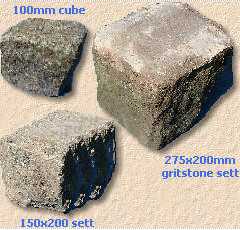
johncoxon 1:20 PM - [Link] - Comments ()
...
NEW HOMES As I have said, Salford has a very high proportion of rented accommodation, with either private landlords or the city actually owning those properties. Some council houses ( those owned and managed by the City) have been put on the market and sold to private buyers. There were, and still are, in central Salford at least, high rise appartment blocks towering above you. These were a quick fix solution to a general housing shortage and a perceived need to replace old slum terraces in one sweep , but they created a lot of problems. Thus, more recent municipal housing is more sympathetic and human in scale , providing people with small separate two-storey housing, often with a patch of garden and boundary fencing.
Friday, February 07, 2003

You will notice that they are open onto the street with a grass verge up front. You will also notice, what has been a recent addition in the area, iron security railings between houses to reduce oportunist crime. There is a social theory about our inborn need for 'defensible teritory' , namely a patch, separate from the next persons, which is yours, private and gives you a sense of security. The planners and architects , perhaps out of a misguided politically correct philosophy, went in for 'open plan housing', with no fences or barriers to mark off plots, and, incredibly, despite what seems a general wish to have clearly marked boundaries, they still plump for this style of layout . Hence , some kids again, I'm afraid, wonder around people's living space with no sense private property, no sense of it belonging to anyone in particular and thus fair game to tresspass upon, or, in some cases do damage, and harrass or aggrevate the occupiers.
Near our home, a short dog's walk away, private developers have built hundreds of new homes on what isn't a very large area of land that backs onto open wetland countryside (that can't be built on mercifully.) The houses are very small and you can see from this photograph, the gardens at the rear are tiny too. To me there is a general feel of too many little boxes squeezed into one site. There are no front boundary walls or fences : to create the illusion of space there are just narrow strips of grass. They sold like hot cakes when they'd been built. I'm not sure why! They look to my eye, almost temporary. I am more than happy to live in our little terraced house , at least it has a sense of permanence and we are relatively lucky in the amount of space we have.
johncoxon 2:55 AM - [Link] - Comments ()
...
CHEAPER HOUSING
Thursday, February 06, 2003
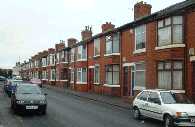
There used to be mile upon mile of brick-built terraced neighbourhoods in northern cities like Manchester and Salford. They were originally built to provide basic accommodation for factory and pit workers. Vast areas of them have been demolished but equally a lot remain. These have been modernised. Although location can affect the price of such homes, ridiculously in some sought-after areas, the one's in this shot, near my school, represent the cheapest form of privately-owned housing around. The wisdom of the sixties was to flatten whole communities of sub-standard terraced accommodation and transplant people into concrete ,factory-built high rise flats and soulless housing estates, thus creating a whole new catalogue of social problems and disaffection. The current wisdom is to re-furbish these areas and try to recapture the lost sense of community.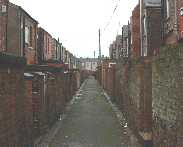
The second shot shows what is known locally as the 'back entry' and demonstrates how small the 'back yards' of such housing really often are. Most of these houses have had modern extensions built on to them to make larger kitchens and bedrooms, further reducing space at the rear. This back entry is reasonably tidy; many are cluttered with discarded furniture,old washing machines, fridges and other litter.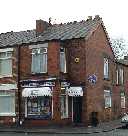
The third shot is an example of an increasingly rare sight, the traditional 'corner shop'. Once flourishing businesses, where you could always nip out and get staple items like bread and milk a stone?s throw from your own doorstep, large supermarkets with more competitive pricing have largely killed them off. This very small neighbourhood convenience store typically sells newspapers, sweets,cigarettes and a small range of foodstuffs.It has a very limited stock, and in the vicinity of my school at least, it is clear, from the shelves, that theirs is not a particularly lucrative trade any longer. The more successful ones survive by having a very wide range of stock, including selling beer and spirits, and are often, owned and run by Asian families with most family members helping out on a sort of shift basis. It requires the old work ethic because, for example, stock has to be bought in from the wholesalers in the early hours and the store normally remains till late at night. It is very hard work and not for the feint hearted.
johncoxon 8:19 AM - [Link] - Comments ()
...
BATHROOM HISTORY LESSON

Our terraced house, originally, had two good-sized bedrooms, each with an open fire place, but the arrangements were modified, in post-Victorian times, to create the luxury of an indoor toilet, bathroom, and smaller bedroom. In the old days, the miner's family went to the shared toilet outside, and bathed in a movable zinc-plated iron tub, plumped into the downstairs front room on bath night,in front of the coal fire, the tub filled with numerous kettles of hot water, handballed from the kitchen!
sense of independence and self-reliance and a gift with tools. It's an attitude, a sort of self belief. A great gift to pass on to a person, and in a way pretty environmentally friendly too! I have great parents and love them so much. They gave me many gifts and through them I became a strong, sensitive, and very happy grown up. Genetically I feel very blessed!
johncoxon 11:15 AM - [Link] - Comments ()
...
Ringing the changes
Tuesday, February 04, 2003
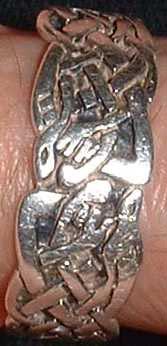
My amazing father has been married for nearly fifty years but only my lovely mother wears the wedding ring. My father is a practical man, and when he witnessed a fellow soldier jump off an armoured vehicle way back( he told me) and have his finger stripped to the bone by his wedding ring, that for dad was justification enough never to wear one.
johncoxon 1:44 AM - [Link] - Comments ()
...
Sunday, February 02, 2003

OUR HOUSE
johncoxon 12:35 PM - [Link] - Comments ()
...
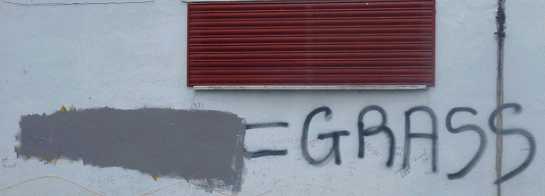
LOCAL URBAN ARTISTS
johncoxon 6:08 AM - [Link] - Comments ()
...